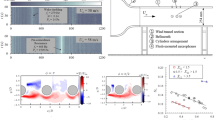Abstract
Unsteady flow dynamics resonated via the natural acoustic mode of a duct with tandem side-branches in a unique half-wavelength arrangement were experimentally investigated. The wavelength corresponded to the first natural acoustic mode of a duct–branch system, which can be easily triggered in a low-speed flow and result in a strong flow–acoustic resonance. Considering the remote arrangement, albeit one involving close flow interactions between the faraway side-branches, a dual particle image velocimetry (PIV) setup was established to simultaneously capture the upstream and downstream side-branches. In addition, an advanced phase-locking technique based on a field-programmable gate array (FPGA) control system and real-time acoustic waveform recognition approach was established to increase the phase-determination accuracy. Using this dual-FPGA-PIV system, the high-frequency acoustically resonated flow dynamics could be accurately divided into multiphase-dependent flow snapshots within an extremely small acoustic period, while ensuring the high spatial resolution of the flow fields. Preliminary pressure measurements and acoustic modal analysis were conducted to confirm the occurrence of flow–acoustic resonance inside such ducts with half-wavelength arranged side-branches. Subsequently, time-averaged flow measurements were obtained using a planar-PIV system to investigate the flow dynamic variations. It was noted that the acoustic modulation effect outweighed the Reynolds number effect and dominated the intensive flow fluctuations in the duct–branch system. Thereafter, phase-dependent flow measurements were obtained using the dual-FPGA-PIV setup to illustrate the spatiotemporal evolutions of the coherent flow structures associated with the resonance in the duct–branch system. Due to the symmetric nature of the resonated first acoustic mode, synchronous in-phase movement of the streamwise shear-layer vortices occurred between the faraway upstream and downstream side-branches.
Graphical abstract













Similar content being viewed by others
References
Amandolese X, Hemon P, Regardin C (2004) An experimental study of the acoustic oscillations by flows over cavities. J Vib Acoust 126(2):190–195
Arthurs D, Ziada S (2009) Flow-excited acoustic resonances of coaxial side-branches in an annular duct. J Fluids Struct 25(1):42–59
Barbieri R, Barbieri N (2006) Finite element acoustic simulation based shape optimization of a muffler. Appl Acoust 67(4):346–357
Deng YF, Wang P, Liu YZ (2019) Phase-locking particle image velocimetry measurement of unsteady flow behaviors: Online dynamic mode decomposition using field-programmable gate array. Phys Fluids 31:025109
El Hassan M, Keirsbulck L, Labraga L (2009) Aero-acoustic coupling inside large deep cavities at low-subsonic speeds. J Fluids Eng 131(1)
Forestier N, Jacquin L, Geffroy P (2003) The mixing layer over a deep cavity at high-subsonic speed. J Fluid Mech 475:101
Graf HR, Durgin WW (1993) Measurement of the nonsteady flow field in the opening of a resonating cavity excited by grazing flow. J Fluids Struct 7(4):387–400
Graftieaux L, Michard M, Grosjean N (2001) Combining PIV, POD and vortex identification algorithms for the study of unsteady turbulent swirling flows. Meas Sci Technol 12(9):1422
Jungowski WM, Botros KK, Studzinski W (1989) Cylindrical side-branch as tone generator. J Sound Vib 131(2):265–285
Keller JJ, Escudier MP (1983) Flow-excited resonances in covered cavities. J Sound Vib 86(2):199–226
Larchevêque L, Sagaut P, Mary I et al (2003) Large-eddy simulation of a compressible flow past a deep cavity. Phys Fluids 15(1):193–210
Li Y, Someya S, Okamoto K, Inagaki T, Nishi Y (2015) Visualization study of flow-excited acoustic resonance in closed tandem side branches using high time-resolved particle image velocimetry. J Mech Sci Technol 29(3):989–999
Okuyama K, Tamura A, Takahashi S et al (2012) Flow-induced acoustic resonance at the mouth of one or two side branches. Nucl Eng Des 249:154–158
Oshkai P (2014) Quantitative flow imaging approach to flow-acoustic coupling in pipeline-cavity systems. J Fluid Sci Technol 9(3):JFST0026
Oshkai P, Barannyk O (2013) Experimental investigation of flow-acoustic coupling in a deep axisymmetric cavity. In:ASME 2013 pressure vessels and piping conference, V004T04A024
Peters MCAM (1993) Aeroacoustic sources in internal flows. Eindhoven University of Technology
Thornber B, Drikakis D (2008) Implicit large-eddy simulation of a deep cavity using high-resolution methods. AIAA J 46(10):2634–2645
Tonon D, Hirschberg A, Golliard J et al (2011a) Aeroacoustics of pipe systems with closed branches. Int J Aeroacoust 10(2–3):201–275
Tonon D, Willems JFH, Hirschberg A (2011b) Self-sustained oscillations in pipe systems with multiple deep side branches: Prediction and reduction by detuning. J Sound Vib 330(24):5894–5912
Wang P, Liu Y (2019) Intensified flow dynamics by second-order acoustic standing-wave mode: Vortex-excited acoustic resonances in channel branches. Phys Fluids 31(3):035105
Wang P, Liu Y (2020a) Influence of diametral acoustic mode on cavity flow dynamics: Zonal large eddy simulation and proper orthogonal decomposition. Phys Fluids 32(7):075103
Wang P, Liu Y (2020b) Spinning behavior of flow-acoustic resonant fields inside a cavity: Vortex-shedding modes and diametral acoustic modes. Phys Fluids 32(8):085109
Wang P, Ma H, Deng Y et al (2018) Influence of vortex-excited acoustic resonance on flow dynamics in channel with coaxial side-branches. Phys Fluids 30(9):095105
Wang P, Deng Y, Liu Y (2019) Vortex dynamics during acoustic-mode transition in channel branches. Phys Fluids 31(8):085109
Wang P, Deng Y, Liu Y (2020) Phase-locking particle image velocimetry measurements of acoustic-driven flow interactions between tandem deep cavities. Phys Fluids 32(32):125115
Xiao Y, Huang C, Li J et al (2020) Flow-induced acoustic resonances in closed tandem side branches with large diameter. Ann Nucl Energy 149:107783
Yang Y, Rockwell D, Cody KLF et al (2009) Generation of tones due to flow past a deep cavity: Effect of streamwise length. J Fluids Struct 25(2):364–388
Ziada S, Lafon P (2014) Flow-excited acoustic resonance excitation mechanism, design guidelines, and counter measures. 66(1)
Ziada S, Bühlmann ET (1992) Self-excited resonances of two side-branches in close proximity. J Fluids Struct 6(5):583–601
Ziada S, Shine S (1999) Strouhal numbers of flow-excited acoustic resonance of closed side branches. J Fluids Struct 13(1):127–142
Acknowledgements
The authors gratefully acknowledge the financial support received from the National Natural Science Foundation of China (Grant Nos.: 12172221, 11802177 and 11725209).
Author information
Authors and Affiliations
Corresponding author
Rights and permissions
About this article
Cite this article
Wang, P., Zhang, Z., He, C. et al. Dual-FPGA-PIV measurements of unsteady flow dynamics resonated via the duct acoustic mode with half-wavelength arranged side-branches. Exp Fluids 63, 29 (2022). https://doi.org/10.1007/s00348-022-03384-y
Received:
Revised:
Accepted:
Published:
DOI: https://doi.org/10.1007/s00348-022-03384-y




